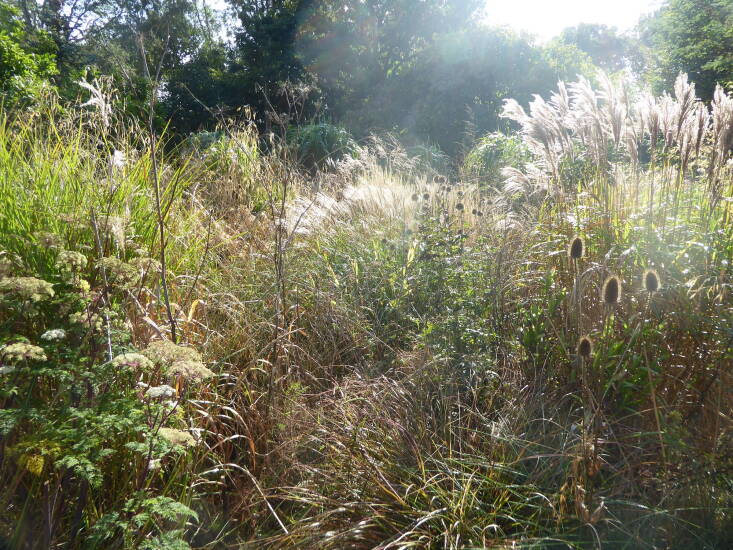Ornamental grasses are among the most forgiving plants for the amateur gardener—providing near instant impact, a very long season of interest, and, in almost all cases, minimal maintenance. At Five Acre Barn, a B&B on the Suffolk coast, England, they are the star of the show.
When David Woodbine bought the site with his partner, Bruce, back in 2015, the garden had been largely planted in the ’60s and ’70s with an array of unappealing conifers and shrubs. They knocked down a 1970s extension and replaced it with a distinctive geometric, cedar-clad structure (designed by architects Blee Halligan) that would house the five guest bedrooms. The land around it presented an equally exciting opportunity. It had to serve several functions: create interest and provide screening to the guest rooms, which all have floor-to-ceiling windows. And it had to be manageable for one person to maintain.
Below, their tips for how best to work ornamental grasses into your garden design.
Photography by Clare Coulson, unless otherwise noted.
1. Plant them in an immersive way.

One of the key inspirations for the garden was a tiger reserve that the couple had visited in India, where a curtain of tall grasses created an immersive feeling around guest rooms and “hinted at the tiger-filled wilderness beyond. We might not have big cats in Suffolk but it reminds people that they are deep in the country,” says David. Gardens closer to home were also influential, especially the feeling at Great Dixter where visitors squeeze down narrow paths and are almost entirely submerged within the planting. “You get to experience the garden from within rather than just observe at arm’s length.”
2. Embrace their diversity.

There was no real plan starting out, but a real interest in form. “Each grass brings something particular, and I have tried to mix them up to build a varied tapestry of different shapes, habits, seed heads, and occasionally color,” says David. And with a lot of space it’s easy to experiment.
Some grasses bring serious heft to the planting. Miscanthus giganteus is a favorite for its vast structural presence (it can grow up to 3 meters tall). Stipa gigantea for its graceful airiness and nodding seedheads that reflect the light. Underneath them a whole sub-story of grasses that mingle and catch the eye. Chasmanthium Latifolium has strappy leaves and beautiful flattened oat seedheads, while two varieties of Pennisetum—alopecuroides ‘Hameln’ and setaceum—are also key here. “They are such crowd-pleasers,” says David. “Like cheerful firework displays that I deploy generously at the edges where they have space to do their thing and are not obstructed by the taller grasses.”
3. Match grasses to your conditions.

“I try and follow the ‘right plant, right place’ mantra and select grasses that will thrive in the sandy, dry conditions we have here,” adds David, who uses local nurseries with plants suited to the soil and climate. “On the east coast the summers tend to be dry, so mulching is essential. We are very lucky to receive chippings from local tree surgeons and this is reapplied each spring.” This extra layer of protection is crucial for plants that are not watered after they are first planted. Grasses that prefer moist conditions are used around a shadier stumpery: “I love its glossy foliage and how it masses over the wood onto the paths.”
4. Add contrasting perennials.

There are plenty of other flowering plants here to catch the eye as well as to attract birds and pollinators into the garden: You’ll find teasels, fennel, knapweed, gaura, eupatorium, echinops, eryngium, and more billowy perennials such as ammi majus, Valerian officianalis and common cow parsley. “The grasses and flowers have combined to create a contrived wilderness that is teeming with wildlife. I am really pleased about this as I originally worried that a sea of ornamental grasses might create some sort of alien landscape that would almost be as barren as the lawn it was replacing.”
5. Include star grasses for autumn and winter.

In autumn, the grasses put on a dazzling display of intense color as their leaves turn. Stars of the show are Molinia Caerulea, which turns a spectacular orange in mid-autumn, and Stipa Arundinacea, which also gives fantastic burnished orange tones. And while ornamental grasses can lose their structure as weather worsens into winter, here they are protected by acres of woodland, and most retain their form. Some of the favorites in this garden for winter interest are the shimmering Miscanthus nepalensis with its metallic plumes, and the winter garden stalwart Calamagrostis x Acutiflora ‘Karl Forster’ with its upright fronds that withstand any amount of weather.
6. Don’t forget about spring interest.

In late winter or early spring everything is cut down to the ground, but at the same time spring bulbs, including narcissi and primroses, are emerging under an established magnolia tree that provides a gorgeous display of pale pink flowers. Beyond the grasses, there is a bed of Cornus alba Sibirica, providing more intense color and drawing the eye out of the garden and into the surrounding countryside.
For more on ornamental grasses, see:
- Pink Grasses: 10 Ideas for Muhlenbergia in a Landscape
- Architect Visit: A Hazy Landscape of Grasses in Santa Monica
- Leaves of Grass: 9 Ways to Create Curb Appeal with Perennial Grasses












Have a Question or Comment About This Post?
Join the conversation